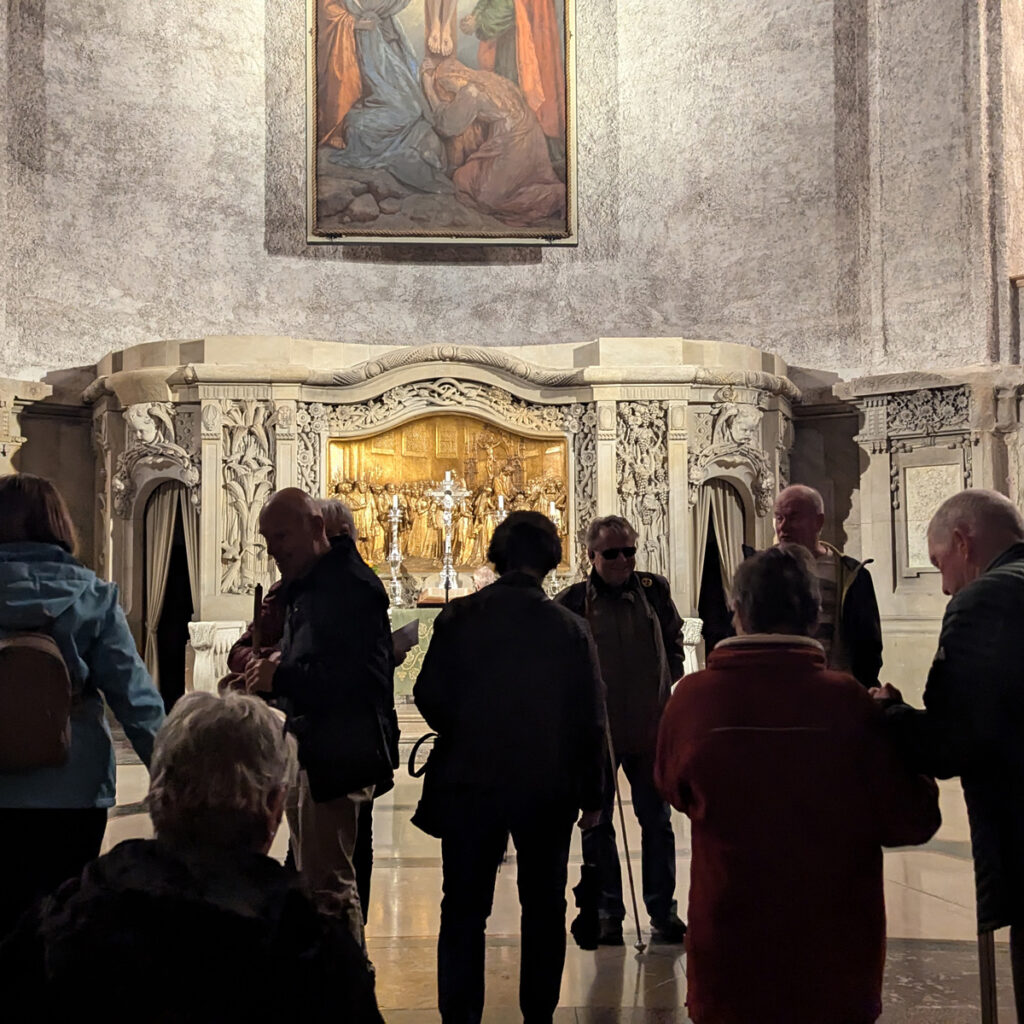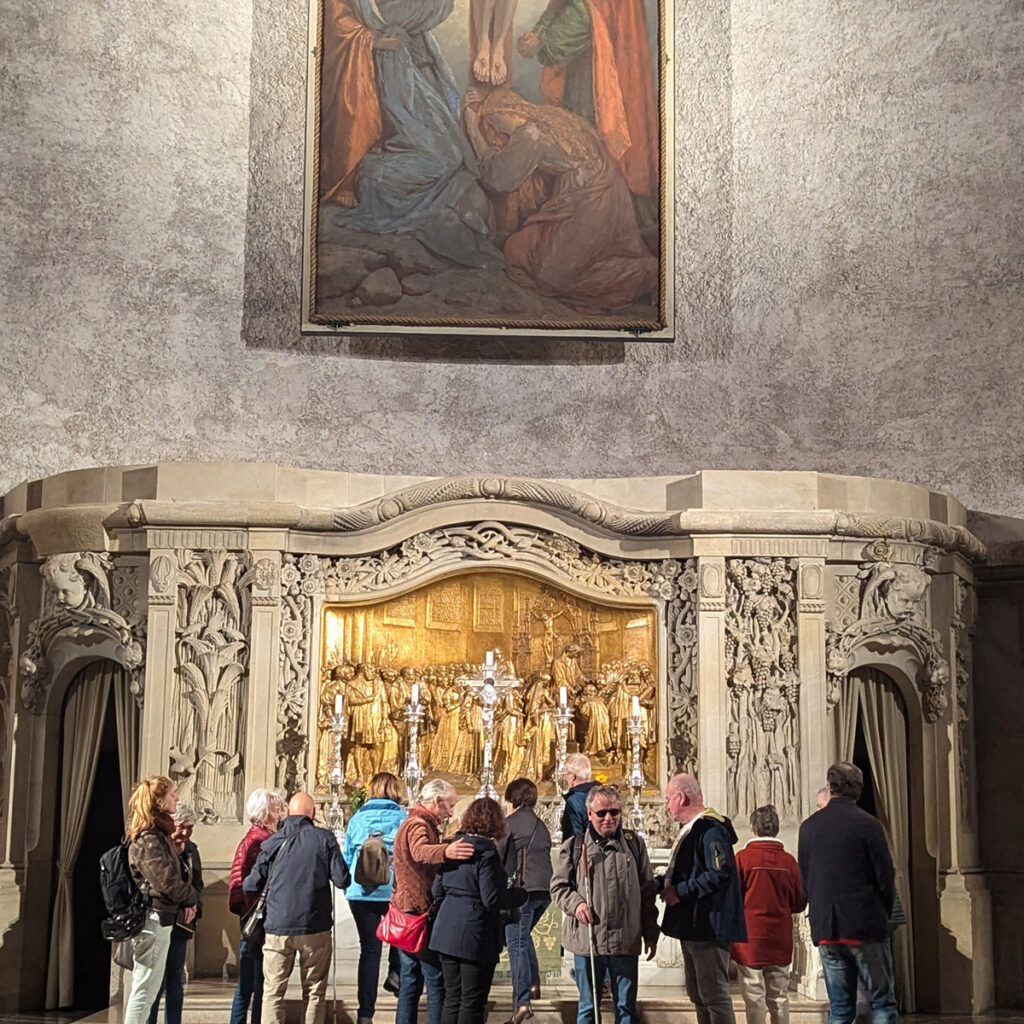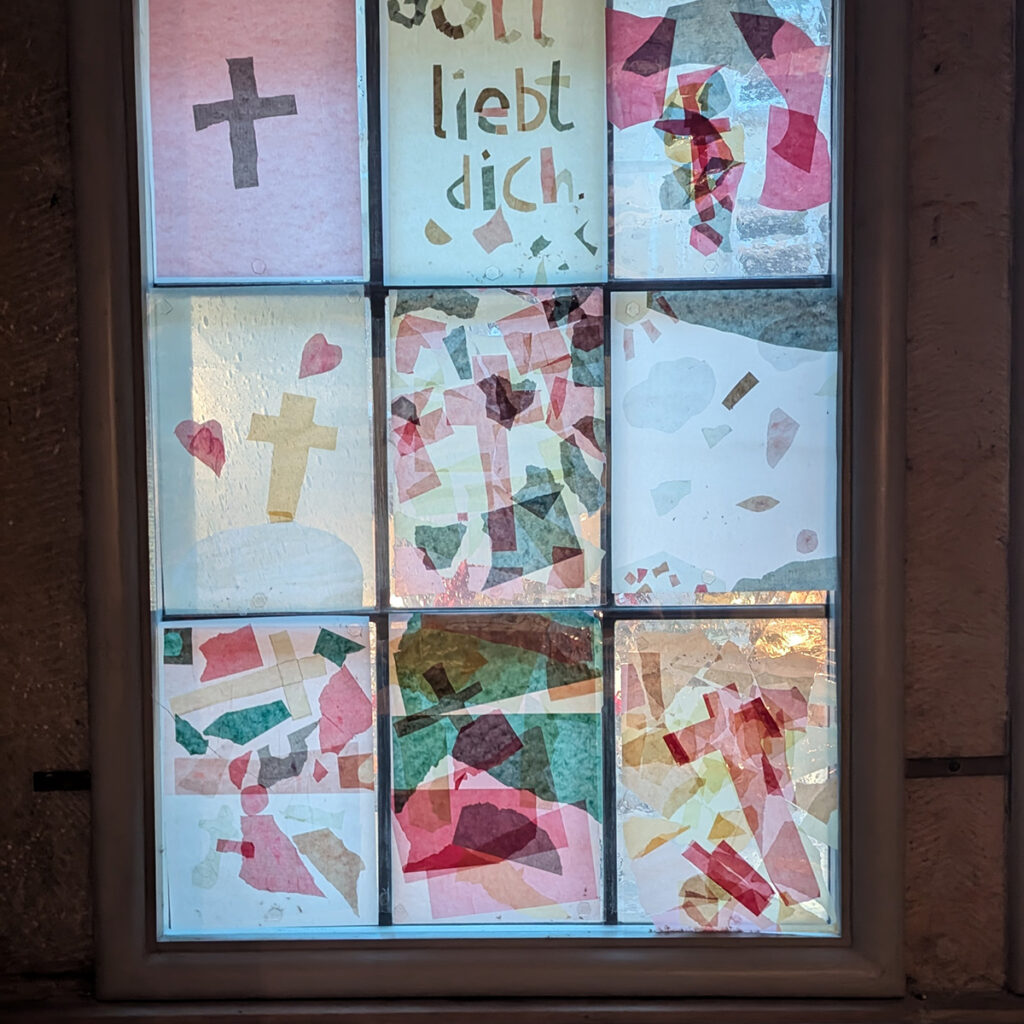
They have their canes with them, some have come accompanied by a sighted person. In cooperation with the Saxony Association for the Blind, Kulturaktiv e.V. is making the city’s most important church tangible today. Because there was already a church here, right on the market square, when the much-photographed Frauenkirche was not even a thought – even when the city was founded 800 years ago.
At the beginning, Anna-Thilo Schmalfeld asks us to face the front of the church. We turn our faces – this word also has to do with “seeing” – to the façade. And with the special experience of many years as a city guide, Anna-Thilo begins to describe it, so impressively that it comes to life in the mind’s eye.
First of all, it’s about the dimensions. This is important, because if you can’t see, you don’t have an initial overview. “If you wanted to recreate the church with cardboard, you wouldn’t have to do much crafting at all: You would only need a shoe box with a separate lid. The tower follows at the top, crowned by a small onion with some remaining garlic.” Instead of using technical art-historical terms that are only of value to those who already have a visual idea of them, Anna-Thilo also vividly describes the columns in front and the “Corinthian column capitals”. “They look like mighty tree trunks. At the top, the trunk is sawn off smoothly, but thanks to its strong roots, it sprouts leaves again at the cut.” Such a description goes to the heart of what the Christian builders had in mind when choosing their symbolism.
But in order to grasp the dimensions of large buildings, it makes sense to simply walk the length and width. We move slowly as a group along the outer wall, accompanied by the sound of canes, metal on stone, clattering against the bottom step of the staircase. This gives even a sighted person a new feeling for the tons of stone that have been moved here. And then we get very close to the outer walls. “Most of the stone you touch has been here for over 230 years.” The blocks of rock, darkened by age, come from the Elbe Sandstone Mountains. We run our fingers along the surface: it is not smooth, but grooved, or “sharpened” in technical jargon. Can you feel the difference between the old blocks and the new, light-colored sandstone surfaces added during the restoration?


The monument in honor of Julius Otto (1804-1877), which has stood to the right of the main portal since 2010, can be felt very well. You can climb up a few steps to feel the bronze bust of the cantor and director of the famous Kreuzchor choir. Beneath his larger-than-life face, four cast choirboys in ancient garb sing from a songbook. Anna-Thilo draws our attention to the fact that we can even feel the beginning of a song text in the songbook: “Das treue, deutsche Herz”. What may have been a progressive commitment to understanding between small German states during Otto’s lifetime seems rather reactionary today, without any commentary. Inspired by Anna-Thilo’s thoughts, I read through the Wikipedia entry. I read that the original monument from 1886 and the model for today’s statues was melted down for war purposes in 1942. So that’s how loyal German patriots are to German culture.
On we go. There are large portals on all four sides of the church, and at one of them Anna-Thilo draws our attention to small wrought-iron constructions anchored in the floor to the right and left of the door. They are doormats – from the time when horse-drawn carts still dominated the townscape and horse manure was not supposed to get into the church! I had never noticed these shoe wipers – even though I was allowed to accompany Anna-Thilo and Lydia Hänsel, deputy chairwoman of the blind association, during the preparations the week before. You can be that blind: If the metal hadn’t been old and rusty, I could have sworn they hadn’t been there the week before. “Looking,” Anna-Thilo had explained to me during the preparation, ”is always a confirmation of what you already know, and therefore always limited. Seeing, looking and contemplating is a gaze with a gain, with a gain in knowledge.”
We have now returned to the front of the church. Anna-Thilo reads out the text of a memorial plaque that is set relatively high up in the wall. This plaque could also be easily overlooked. It is one of the few places in Dresden that clearly names the crimes committed by the Germans under National Socialism. In 1933, it reads, there were 4675 Jews living in Dresden. In 1945 there were 70.


We enter the interior of the church shortly after the bell rings at 6 pm. Visiting time is actually over now, but we are lucky that the lady from the security desk works an extra hour for us. This means we can move around freely without tripping over other tourists. Anna-Thilo explains that, contrary to popular belief, the Kreuzkirche was by no means completely destroyed at the end of the war. It had merely burned down, as it had in 1897 when the church was redesigned in Art Nouveau style. The fact that the room is still so sparse and only the lower part of the altar remains is thanks to a somewhat brutal design approach in the 1950s. At the time, they also wanted to replaster the walls. But the work was never completed; the temporary solution of rough and irregularly applied mortar became permanent. From a distance, this rough plaster looks like a fluffy gray carpet covering to me as a sighted person. What a great contrast when I touch it at body height, how hard and sharp-edged it is.
Stone vines and ears of grain have been preserved in the chancel from the Art Nouveau period. We can also feel them as we explore the chancel. And for once, I let the sense of touch, not the eye, take precedence: the marble and the sandstone also differ in their smooth and grainy surfaces, and even in their temperature. The marble is cold to the touch, but the sandstone is warm to the touch. And the metal of the candlesticks and the font – I would almost say that it feels shiny. Or am I just saying that because I can’t imagine life without sight?
We walk down the steps, back into the church. Soon the famous Kreuzchor choir will be singing its Christmas oratorio here again. There must be good reasons why the world’s religions not only rely on things that can be seen – but also on the sense of hearing.
Birthe Mühlhoff
Dresden spricht …
Workshops, tours, writing and printing workshops under the motto “Dresden speaks many languages”

Period
03-12.2024
Porject coordination
Yvonn Spauschus (Projektleitung)
Yulia Vishnichenko · Moussa Mbarek · Nadine Wölk · Rosa Brockelt · Yuliya Firsova · Martin Mannig (workshop leader)
Rosa Brockelt · Rosa Hauch · Falk Goernert · Birthe Mühlhoff (moderation, documentation)
Adina Rieckmann · Lydia Hänsel (tourguides)
Inge · Mahsa · Karin (voluntary help)
Cooperation partners
JugendKunstschule Dresden – Standort Passage, Omse e.V., Nachbarschaftshilfeverein, Stadtteilverein Johannstadt e.V., Malteser Hilfsdienste e.V., Jugendhaus LILA as well as Chinesisch-Deutsches Zentrum e.V., Lebenshilfe Dresden e.V., GEH8 Kunstraum und Ateliers e.V., Umweltzentrum Dresden – ABC Tische and many more
Supported by
The project is funded by the State Ministry for Social Affairs and Social Cohesion. This measure is co-financed with tax funds on the basis of the budget passed by the Saxon state parliament within the framework of the state programme Integrative Maßnahmen.
